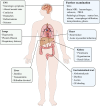Neurological involvement in hematopoietic stem cell transplantation-associated thrombotic microangiopathy
- PMID: 38763940
- PMCID: PMC11358180
- DOI: 10.1007/s00277-024-05798-6
Neurological involvement in hematopoietic stem cell transplantation-associated thrombotic microangiopathy
Abstract
Transplantation-associated thrombotic microangiopathy (TA-TMA) is a well-recognized serious complication of hematopoietic stem cell transplantation (HSCT). The understanding of TA-TMA pathophysiology has expanded in recent years. Dysregulation of the complement system is thought to cause endothelial injury and, consequently, microvascular thrombosis and tissue damage. TA-TMA can affect multiple organs, and each organ exhibits specific features of injury. Central nervous system (CNS) manifestations of TA-TMA include posterior reversible encephalopathy syndrome, seizures, and encephalopathy. The development of neurological dysfunction is associated with a significantly lower overall survival in patients with TA-TMA. However, there are currently no established histopathological or radiological criteria for the diagnosis of CNS TMA. Patients who receive total body irradiation (TBI), calcineurin inhibitors (CNI), and severe acute and chronic graft-versus-host disease (GVHD) are at a high risk of experiencing neurological complications related to TA-TMA and should be considered for directed TA-TMA therapy. However, the incidence and clinical manifestations of TA-TMA neurotoxicity remain unclear. Studies specifically examining the involvement of CNS in TMA syndromes are limited. In this review, we discuss clinical manifestations and imaging abnormalities in patients with nervous system involvement in TA-TMA. We summarize the mechanisms underlying TA-TMA and its neurological complications, including endothelial injury, evidence of complement activation, and treatment options for TA-TMA.
Keywords: Endothelial injury; Hematopoietic stem cell transplantation; Neurological involvement; Thrombotic microangiopathy.
© 2024. The Author(s).
Conflict of interest statement
The authors declare that they have no conflict of interest.
Figures



Similar articles
-
Emerging Concepts in Hematopoietic Stem Cell Transplantation-Associated Renal Thrombotic Microangiopathy and Prospects for New Treatments.Am J Kidney Dis. 2018 Dec;72(6):857-865. doi: 10.1053/j.ajkd.2018.06.013. Epub 2018 Aug 23. Am J Kidney Dis. 2018. PMID: 30146419 Review.
-
[Advances in Diagnosis and Treatment of Transplant-Associated Thrombotic Microangiopathy --Review].Zhongguo Shi Yan Xue Ye Xue Za Zhi. 2023 Apr;31(2):602-606. doi: 10.19746/j.cnki.issn.1009-2137.2023.02.044. Zhongguo Shi Yan Xue Ye Xue Za Zhi. 2023. PMID: 37096542 Review. Chinese.
-
A new paradigm: Diagnosis and management of HSCT-associated thrombotic microangiopathy as multi-system endothelial injury.Blood Rev. 2015 May;29(3):191-204. doi: 10.1016/j.blre.2014.11.001. Epub 2014 Nov 28. Blood Rev. 2015. PMID: 25483393 Free PMC article. Review.
-
Early Increase in Complement Terminal Pathway Activation Marker sC5b-9 Is Predictive for the Development of Thrombotic Microangiopathy after Stem Cell Transplantation.Biol Blood Marrow Transplant. 2018 May;24(5):989-996. doi: 10.1016/j.bbmt.2018.01.009. Epub 2018 Jan 12. Biol Blood Marrow Transplant. 2018. PMID: 29339271
-
Clinical Outcomes and Treatment Strategies of Adult Transplant-Associated Thrombotic Microangiopathy: External Validation of Harmonizing Definitions and High-Risk Criteria.Am J Hematol. 2025 May;100(5):830-839. doi: 10.1002/ajh.27651. Epub 2025 Mar 6. Am J Hematol. 2025. PMID: 40047384 Free PMC article.
References
-
- Elsallabi O, Bhatt VR, Dhakal P et al (2016) Hematopoietic stem cell transplant-associated thrombotic microangiopathy. Clin Appl Thromb Hemost 22(1):12–20 - PubMed
-
- Yamada R, Nemoto T, Ohashi K et al (2020) Distribution of transplantation-associated thrombotic microangiopathy (TA-TMA) and comparison between renal TA-TMA and intestinal TA-TMA: Autopsy study. Biol Blood Marrow Transplant 26(1):178–188 - PubMed
-
- Warren M, Jodele S, Dandoy C et al (2017) A complete histologic approach to gastrointestinal biopsy from hematopoietic stem cell transplant patients with evidence of transplant-associated gastrointestinal thrombotic microangiopathy. Arch Pathol Lab Med 141(11):1558–1566 - PubMed
-
- Laskin BL, Goebel J, Davies SM et al (2011) Small vessels, big trouble in the kidneys and beyond: Hematopoietic stem cell transplantation-associated thrombotic microangiopathy. Blood 118(6):1452–1462 - PubMed
Publication types
MeSH terms
Substances
Grants and funding
LinkOut - more resources
Full Text Sources

